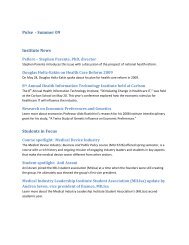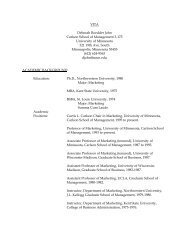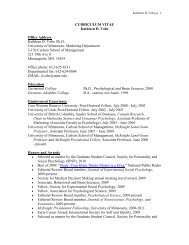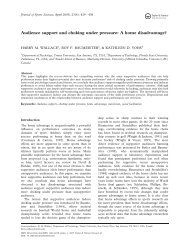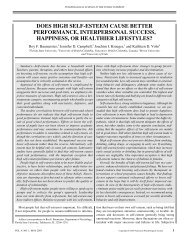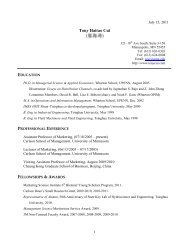Extending Culturally Symbolic Brands - Carlson School of ...
Extending Culturally Symbolic Brands - Carlson School of ...
Extending Culturally Symbolic Brands - Carlson School of ...
You also want an ePaper? Increase the reach of your titles
YUMPU automatically turns print PDFs into web optimized ePapers that Google loves.
EXTENDING CULTURALLY SYMBOLIC BRANDS 935<br />
cus on the extension’s perceived fit, a highly diagnostic input<br />
for evaluating the new product (e.g., Aaker and Keller 1990;<br />
Ahluwalia and Gurhan-Canli 2000). In other words, the cultural<br />
congruency <strong>of</strong> the brand and extension product category<br />
and the accompanying experience <strong>of</strong> fluency are likely<br />
to influence extension evaluation over and above analytical<br />
assessments <strong>of</strong> fit.<br />
What if the brand and the product category activated incongruent<br />
or different cultural schemas? Interestingly, to the<br />
best <strong>of</strong> our knowledge, research in conceptual fluency has<br />
failed to consider the effects <strong>of</strong> activating an inconsistent<br />
schema on stimulus evaluations. It is well established that<br />
people develop less favorable attitudes toward objects that<br />
are perceptually disfluent compared to those that are fluent<br />
(Reber et al. 2004). However, because the empirical evidence<br />
bearing on this finding comes from direct comparison<br />
between disfluent and fluent conditions, it is difficult to<br />
determine whether disfluency is truly a disadvantage. More<br />
direct evidence for the effects <strong>of</strong> disfluency on evaluations<br />
come from related research in goal fluency (e.g., Labroo<br />
and Lee 2006). For instance, when a brand is primed through<br />
prior exposure to a related product (e.g., Not Nice to Lice<br />
shampoo precedes processing <strong>of</strong> Raid insect killer), consumers<br />
experience inhibited processing <strong>of</strong> the brand if the<br />
regulatory goal addressed by it conflicts with that addressed<br />
by the related product, and the experience <strong>of</strong> inhibited processing<br />
results in the brand being less preferred.<br />
Goals are cognitive structures with properties that are<br />
similar in many respects to those <strong>of</strong> cultural schemas. Goals<br />
are mental networks that include desirable end states, associated<br />
means, and contexts that, once activated, can guide<br />
behavior in goal-congruent directions (Shah, Kruglanski,<br />
and Friedman 2003). Similarly, cultural schemas are loose<br />
networks <strong>of</strong> beliefs, values, and objects that, once activated,<br />
can guide cognition in a culturally consistent fashion (Hong<br />
et al. 2000; Oyserman 2009; Shavitt, Torelli, and Wong<br />
2009). <strong>Extending</strong> the goal disfluency effects to the brand<br />
extension context, it stands to reason that conceptual disfluency<br />
(vs. a baseline) invoked by the simultaneous activation<br />
<strong>of</strong> incongruent cultural schemas by a brand extension<br />
should result in lower extension evaluations. For example,<br />
consider the concept <strong>of</strong> Sony cappuccino machines—the<br />
Sony brand is iconic <strong>of</strong> Japan whereas cappuccino machines<br />
are likely to trigger the Italian schema. When two contrasting<br />
cultural schemas are activated, their incongruency is likely<br />
to result in a decreased fluency or ease in processing the<br />
new product. This sense <strong>of</strong> unease or disfluency generated<br />
by the incongruency is likely to make consumers less receptive<br />
to the extension, overriding the effects <strong>of</strong> conscious<br />
elaboration on the fit between Sony and cappuccino machines.<br />
Importantly, we argue that the above-described cultural<br />
congruity effects are likely to emerge only when both the<br />
brand and the extension are culturally symbolic: conceptual<br />
fluency resulting when the extension is associated with the<br />
cultural schema activated by the parent brand, and disfluency<br />
arising when the extension activates a different, incongruent<br />
cultural schema. These effects are unlikely to emerge when<br />
the brand or product has weaker cultural associations that<br />
are not strong enough to automatically activate a cultural<br />
schema (Fiske and Pavelchak 1986), and hence result in the<br />
(dis)fluency effects. In these contexts, extension judgments<br />
are likely to be driven primarily by the analytical assessment<br />
<strong>of</strong> perceived fit documented in past research (e.g., Aaker<br />
and Keller 1990; Broniarczyk and Alba 1994). For instance,<br />
an extension such as Sony toaster ovens, where the extension<br />
category <strong>of</strong> toaster ovens is not culturally symbolic, is unlikely<br />
to exhibit cultural congruity effects, not affording<br />
Sony any advantage or disadvantage over less iconic brands.<br />
At this point, it is important to note that although the<br />
cultural congruity (CC) process outlined above appears to<br />
have some similarity to the COO effect examined in past<br />
literature (e.g., Gurhan-Canli and Maheswaran 2000; Hong<br />
and Kang 2006), and the brand’s COO is likely to be a part<br />
<strong>of</strong> the cultural schema, these are two distinct effects. Specifically,<br />
the typical COO effect implies that the perception<br />
<strong>of</strong> a brand’s COO (e.g., its manufacturing expertise) is likely<br />
to influence its (extension) evaluation. However, this effect<br />
does not consider either (1) the strength <strong>of</strong> association between<br />
the COO and the brand, or (2) the cultural symbolism<br />
<strong>of</strong> the extension product category, both <strong>of</strong> which are prerequisites<br />
for the CC effect. In other words, the CC is a<br />
more automatic effect that is likely to emerge only when<br />
both the brand and its extension product category are culturally<br />
symbolic; however, COO effects, which are more<br />
deliberate in nature (e.g., Gurhan-Canli and Maheswaran<br />
2000), do not require either the brand or its extension to be<br />
a cultural symbol. Consider, for instance, two American beer<br />
brands: Coors and Budweiser. Budweiser is symbolic <strong>of</strong> the<br />
American culture and hence likely to automatically trigger<br />
the American schema; however, although consumers are<br />
aware <strong>of</strong> Coors’s American origins, it is not a cultural icon<br />
and hence unlikely to trigger this cultural schema. If both<br />
brands attempt an extension into the tequila category (symbolic<br />
<strong>of</strong> Mexican culture), for which their perceived COO<br />
manufacturing expertise is similarly low (since both are<br />
American), a COO-based explanation would predict similarly<br />
low evaluations for both extensions. However, in contrast,<br />
the proposed CC framework would predict lower evaluation<br />
<strong>of</strong> the Budweiser (vs. Coors) extension because <strong>of</strong><br />
the disfluency it is likely to evoke—given that both the brand<br />
and the extension category are culturally symbolic only for<br />
this extension (see conceptual framework in fig. 1).<br />
Four studies were conducted to test the predictions in this<br />
research. Study 1 examines the basic cultural (in)congruity<br />
effect using a research paradigm from the conceptual fluency<br />
literature. Study 2 directly investigates the cultural congruity<br />
effects in the context <strong>of</strong> moderate- and low-fit extensions<br />
for a well-known brand (Sony, a Japanese icon). Study 3<br />
examines the implications <strong>of</strong> the conceptual framework with<br />
multiple brands and tests the mediating role <strong>of</strong> processing<br />
fluency. Study 4 extends the findings to low-fit extensions<br />
by narrow brands and attempts to rule out alternative explanations,<br />
based on COO effects, for the observed findings.



